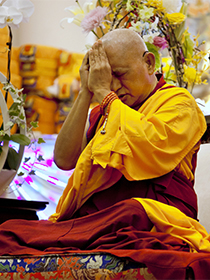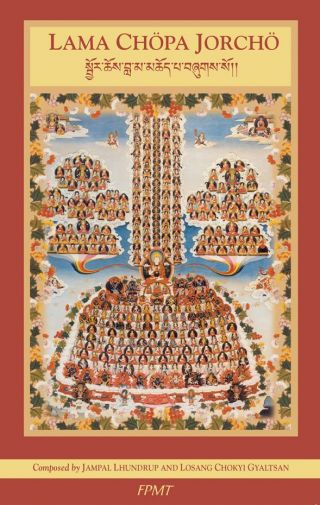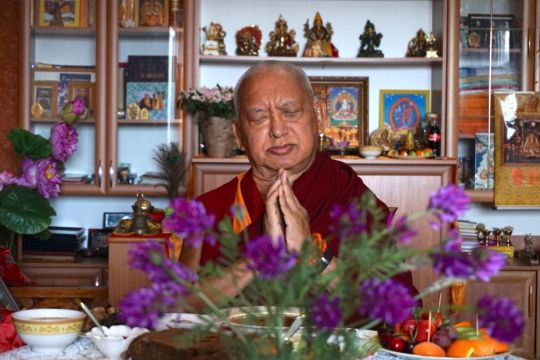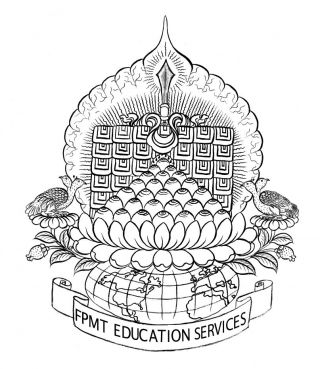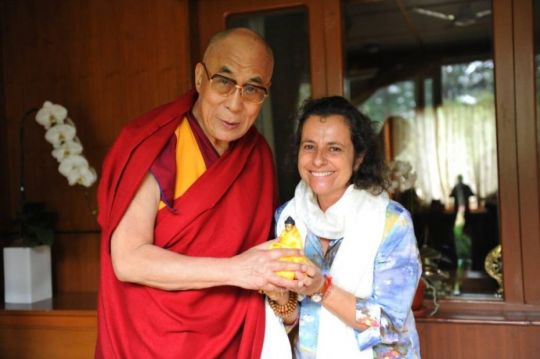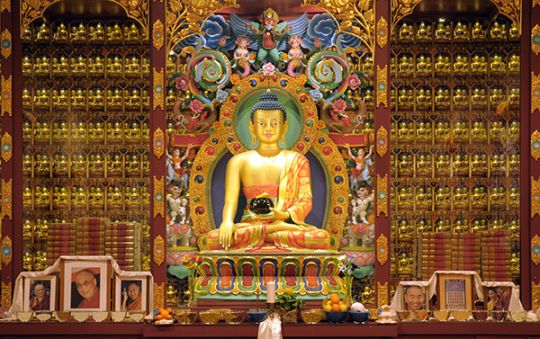- Home
- FPMT Homepage
Foundation for the Preservation of the Mahayana Tradition
The FPMT is an organization devoted to preserving and spreading Mahayana Buddhism worldwide by creating opportunities to listen, reflect, meditate, practice and actualize the unmistaken teachings of the Buddha and based on that experience spreading the Dharma to sentient beings. We provide integrated education through which people’s minds and hearts can be transformed into their highest potential for the benefit of others, inspired by an attitude of universal responsibility and service. We are committed to creating harmonious environments and helping all beings develop their full potential of infinite wisdom and compassion. Our organization is based on the Buddhist tradition of Lama Tsongkhapa of Tibet as taught to us by our founders Lama Thubten Yeshe and Lama Thubten Zopa Rinpoche.
- Willkommen
Die Stiftung zur Erhaltung der Mahayana Tradition (FPMT) ist eine Organisation, die sich weltweit für die Erhaltung und Verbreitung des Mahayana-Buddhismus einsetzt, indem sie Möglichkeiten schafft, den makellosen Lehren des Buddha zuzuhören, über sie zur reflektieren und zu meditieren und auf der Grundlage dieser Erfahrung das Dharma unter den Lebewesen zu verbreiten.
Wir bieten integrierte Schulungswege an, durch denen der Geist und das Herz der Menschen in ihr höchstes Potential verwandelt werden zum Wohl der anderen – inspiriert durch eine Haltung der universellen Verantwortung und dem Wunsch zu dienen. Wir haben uns verpflichtet, harmonische Umgebungen zu schaffen und allen Wesen zu helfen, ihr volles Potenzial unendlicher Weisheit und grenzenlosen Mitgefühls zu verwirklichen.
Unsere Organisation basiert auf der buddhistischen Tradition von Lama Tsongkhapa von Tibet, so wie sie uns von unseren Gründern Lama Thubten Yeshe und Lama Thubten Zopa Rinpoche gelehrt wird.
- Bienvenidos
La Fundación para la preservación de la tradición Mahayana (FPMT) es una organización que se dedica a preservar y difundir el budismo Mahayana en todo el mundo, creando oportunidades para escuchar, reflexionar, meditar, practicar y actualizar las enseñanzas inconfundibles de Buda y en base a esa experiencia difundir el Dharma a los seres.
Proporcionamos una educación integrada a través de la cual las mentes y los corazones de las personas se pueden transformar en su mayor potencial para el beneficio de los demás, inspirados por una actitud de responsabilidad y servicio universales. Estamos comprometidos a crear ambientes armoniosos y ayudar a todos los seres a desarrollar todo su potencial de infinita sabiduría y compasión.
Nuestra organización se basa en la tradición budista de Lama Tsongkhapa del Tíbet como nos lo enseñaron nuestros fundadores Lama Thubten Yeshe y Lama Zopa Rinpoche.
A continuación puede ver una lista de los centros y sus páginas web en su lengua preferida.
- Bienvenue
L’organisation de la FPMT a pour vocation la préservation et la diffusion du bouddhisme du mahayana dans le monde entier. Elle offre l’opportunité d’écouter, de réfléchir, de méditer, de pratiquer et de réaliser les enseignements excellents du Bouddha, pour ensuite transmettre le Dharma à tous les êtres. Nous proposons une formation intégrée grâce à laquelle le cœur et l’esprit de chacun peuvent accomplir leur potentiel le plus élevé pour le bien d’autrui, inspirés par le sens du service et une responsabilité universelle. Nous nous engageons à créer un environnement harmonieux et à aider tous les êtres à épanouir leur potentiel illimité de compassion et de sagesse. Notre organisation s’appuie sur la tradition guéloukpa de Lama Tsongkhapa du Tibet, telle qu’elle a été enseignée par nos fondateurs Lama Thoubtèn Yéshé et Lama Zopa Rinpoché.
Visitez le site de notre Editions Mahayana pour les traductions, conseils et nouvelles du Bureau international en français.
Voici une liste de centres et de leurs sites dans votre langue préférée
- Benvenuto
L’FPMT è un organizzazione il cui scopo è preservare e diffondere il Buddhismo Mahayana nel mondo, creando occasioni di ascolto, riflessione, meditazione e pratica dei perfetti insegnamenti del Buddha, al fine di attualizzare e diffondere il Dharma fra tutti gli esseri senzienti.
Offriamo un’educazione integrata, che può trasformare la mente e i cuori delle persone nel loro massimo potenziale, per il beneficio di tutti gli esseri, ispirati da un’attitudine di responsabilità universale e di servizio.
Il nostro obiettivo è quello di creare contesti armoniosi e aiutare tutti gli esseri a sviluppare in modo completo le proprie potenzialità di infinita saggezza e compassione.
La nostra organizzazione si basa sulla tradizione buddhista di Lama Tsongkhapa del Tibet, così come ci è stata insegnata dai nostri fondatori Lama Thubten Yeshe e Lama Zopa Rinpoche.
Di seguito potete trovare un elenco dei centri e dei loro siti nella lingua da voi prescelta.
- 欢迎 / 歡迎
简体中文
“护持大乘法脉基金会”( 英文简称:FPMT。全名:Foundation for the Preservation of the Mahayana Tradition) 是一个致力于护持和弘扬大乘佛法的国际佛教组织。我们提供听闻,思维,禅修,修行和实证佛陀无误教法的机会,以便让一切众生都能够享受佛法的指引和滋润。
我们全力创造和谐融洽的环境, 为人们提供解行并重的完整佛法教育,以便启发内在的环宇悲心及责任心,并开发内心所蕴藏的巨大潜能 — 无限的智慧与悲心 — 以便利益和服务一切有情。
FPMT的创办人是图腾耶喜喇嘛和喇嘛梭巴仁波切。我们所修习的是由两位上师所教导的,西藏喀巴大师的佛法传承。
繁體中文
護持大乘法脈基金會”( 英文簡稱:FPMT。全名:Found
ation for the Preservation of the Mahayana Tradition ) 是一個致力於護持和弘揚大乘佛法的國際佛教組織。我們提供聽聞, 思維,禪修,修行和實證佛陀無誤教法的機會,以便讓一切眾生都能 夠享受佛法的指引和滋潤。 我們全力創造和諧融洽的環境,
為人們提供解行並重的完整佛法教育,以便啟發內在的環宇悲心及責 任心,並開發內心所蘊藏的巨大潛能 — 無限的智慧與悲心 – – 以便利益和服務一切有情。 FPMT的創辦人是圖騰耶喜喇嘛和喇嘛梭巴仁波切。
我們所修習的是由兩位上師所教導的,西藏喀巴大師的佛法傳承。 察看道场信息:
- FPMT Homepage
- News/Media
-
- Study & Practice
-
-
- About FPMT Education Services
- Latest News
- Programs
- New to Buddhism?
- Buddhist Mind Science: Activating Your Potential
- Heart Advice for Death and Dying
- Discovering Buddhism
- Living in the Path
- Exploring Buddhism
- FPMT Basic Program
- FPMT Masters Program
- FPMT In-Depth Meditation Training
- Maitripa College
- Lotsawa Rinchen Zangpo Translator Program
- Universal Education for Compassion & Wisdom
- Online Learning Center
-
- Prayers & Practice Materials
- Overview of Prayers & Practices
- Full Catalogue of Prayers & Practice Materials
- Explore Popular Topics
- Benefiting Animals
- Chenrezig Resources
- Death & Dying Resources
- Lama Chopa (Guru Puja)
- Lama Zopa Rinpoche: Compendium of Precious Instructions
- Lama Zopa Rinpoche: Life Practice Advice
- Lama Zopa Rinpoche Practice Series
- Lamrim Resources
- Mantras
- Prayer Book Updates
- Purification Practices
- Sutras
- Thought Transformation (Lojong)
- Audio Materials
- Dharma Dates - Tibetan Calendar
- Translation Services
- Publishing Services
- Ways to Offer Support
- Prayers & Practice Materials
-
- Teachings and Advice
- Find Teachings and Advice
- Lama Zopa Rinpoche Advice Page
- Lama Zopa Rinpoche: Compendium of Precious Instructions
- Lama Zopa Rinpoche Video Teachings
- ༧སྐྱབས་རྗེ་བཟོད་པ་རིན་པོ་ཆེ་མཆོག་ནས་སྩལ་བའི་བཀའ་སློབ་བརྙན་འཕྲིན།
- Podcasts
- Lama Yeshe Wisdom Archive
- Buddhism FAQ
- Dharma for Young People
- Resources on Holy Objects
- Teachings and Advice
-
-
*If a menu item has a submenu clicking once will expand the menu clicking twice will open the page.
-
-
- Centers
-
- Teachers
-
- Projects
-
-
-
-
*If a menu item has a submenu clicking once will expand the menu clicking twice will open the page.
-
-
- FPMT
-
-
-
-
-
Cultivating a close, warmhearted feeling for others automatically puts the mind at ease. From the least to the most important event, the affection and respect of others are vital for our happiness.
His Holiness the Dalai Lama
-
-
-
- Shop
-
-
-
The Foundation Store is FPMT’s online shop and features a vast selection of Buddhist study and practice materials written or recommended by our lineage gurus. These items include homestudy programs, prayers and practices in PDF or eBook format, materials for children, and other resources to support practitioners.
Items displayed in the shop are made available for Dharma practice and educational purposes, and never for the purpose of profiting from their sale. Please read FPMT Foundation Store Policy Regarding Dharma Items for more information.
-
-
Study & Practice News
13
The Inner Job Description Card: A Mindfulness Practice Tool
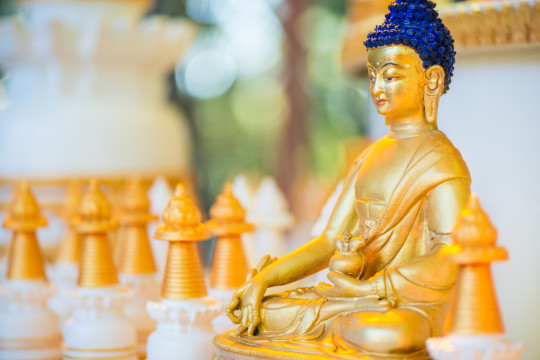
Medicine Buddha, Kachoe Dechen Ling, Aptos, California, US, July 2014. Photo by Chris Majors.
The Inner Job Description Card (Mindfulness Practice Tool) was created to help those offering service to FPMT track their progress throughout the day as they attempt to develop the inner professional and subdue outer expressions of ignorance, anger, attachment, and selfish motivation. As Lama Zopa Rinpoche explains, “You have all these external professions—how to do this, how to do that from school, college, university—but without inner professionalism: how to live life, how to do everything mentally, how to do everything—business, professional activity, whatever you do—with pure attitude, positive mind, non-ignorance, non-anger, non-attachment, especially with the non-selfish mind.”
During the 2014 CPMT meeting in Bendigo, Australia, François Lecointre led a talk and meditation on the Inner Job Description. All are welcome to watch and participate via YouTube:
https://www.youtube.com/watch?v=V0gYX3CL8Ew
Inner Job Description Cards
- Inner Job Description Card (Mindfulness Practice Tool) a4 format
- Inner Job Description Card (Mindfulness Practice Tool) letter format
- “How to Be a Real Professional” by Lama Zopa Rinpoche
You can also attend the Inner Job Description Service Seminar. Find out more on our Service Seminar page.
Through comprehensive study programs, practice materials, training seminars, and scholarships, FPMT Education nourishes the development of compassion, wisdom, kindness, and true happiness in individuals of all ages.
- Tagged: inner job description
6
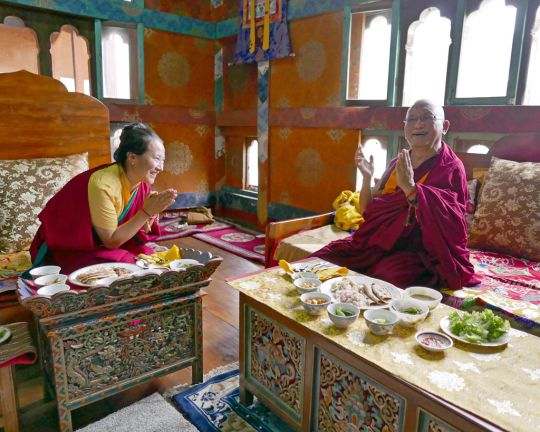
Lama Zopa Rinpoche and Khadro-la enjoying lunch together in Bhutan, May 2016. Photo by Ven. Roger Kunsang.
Khadro-la (Rangjung Neljorma Khadro Namsel Drönme) is consulted every year for advice on practices to clear obstacles for Lama Zopa Rinpoche’s health and long life. In 2016 she advised that all the students in all FPMT centers, projects, and services come together and offer a long life puja to Rinpoche and do 100,000 tsog offerings. This advice resulted in the beautiful long life puja held March 13 at Amitabha Buddhist Centre in Singapore. Khadro-la was not physically present at the long life puja, but the day before, she spontaneously composed a prayer for Lama Zopa Rinpoche, which was offered during the puja. The English translation of the prayer was read for all to hear while Rinpoche received the prayer in Tibetan.
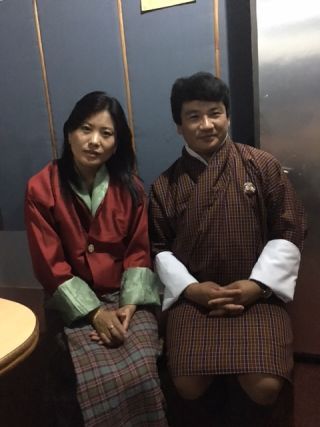
Pema Lhamo and Pema Samdrup
We are pleased to make the prayer available in a variety of languages and formats, including the newly revised English version with Tibetan phonetics and Tibetan script.
Recently, two Bhutanese singers, Pema Lhamo and Pema Samdrup, composed two tunes for this prayer, both of which Lama Zopa Rinpoche enjoyed. He asked that their recordings be played at big retreats during break times or while students are waiting in the gompa. He also asked that both or either of these tunes be learned and used when offering the prayer. We are delighted to offer Rinpoche’s students these lovely tunes—with music or with guitar—and we hope that you will download and learn them for your own practice.
This year, Khadro-la advised that students of Lama Zopa Rinpoche offer recitations of the Vajra Cutter Sutra and Dependent Arising: A Praise of the Buddha (Tendrel Topa) for Rinpoche’s long life. FPMT International Office has requested everyone to join in and keep track of their recitations during the rest of this Tibetan year. The total number of recitations will be offered to Rinpoche at a later date.
Through comprehensive study programs, practice materials, training seminars, and scholarships, FPMT Education nourishes the development of compassion, wisdom, kindness, and true happiness in individuals of all ages.
29
FPMT Education Services: The Heart of FPMT
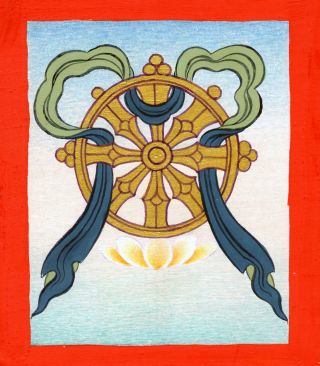
Dharma wheel painted by Gelek Sherpa
FPMT Education Services develops, reviews, and constantly improves a range of introductory to advanced Buddhist education programs available in FPMT centers and online; publishes practice materials in digital and hard copy formats; works with translators and editors to translate crucial texts; and oversees the registration process for and provides support to non-Tibetan teachers.
With all that we offer, we wanted to remind you of some of the services available to you and your Dharma community:
Education Programs
FPMT education programs help students learn, study, and meditate on the Dharma. We offer a range of Buddhist study programs, available in FPMT centers, as homestudy courses, or online through the FPMT Online Learning Center. From introductory courses to opportunities to study the highest philosophical texts, we provide everything needed to learn, practice, and fully realize the Buddha’s teachings.
Practice Materials
FPMT Education Services produces a variety of prayer books, practices, and texts available as hard copy materials and/or ebooks and PDF downloads. Most of our practice materials are offered as free downloads or by donation only.
Translations
FPMT Translation Services is responsible for overseeing the standardization of English translation terminology within the FPMT, revising existing translations, and managing the production of new translations. We work with translators around the world to translate Tibetan texts into various languages. If you would like to help fund this beneficial translation work, please see our FPMT Translation Fund.
Teachers
The Teacher Registration Committee is responsible for overseeing the registration process for teachers qualified to teach in FPMT centers, projects, and services; provides support to registered teachers; creates and adjusts teacher-related policies; and works with centers on teacher invites. Lama Zopa Rinpoche has explained, “Offering qualified teachers, teaching the correct path to enlightenment, is one very powerful thing we can do for sentient beings. We are able to give sentient beings the correct path to enlightenment. In the world, even with Buddhism, there can be misunderstandings of the teachings, wrong teachings, and if one practices those, one can’t achieve and complete the path.”
We hope that you will take advantage of all that FPMT Education Services has available to support your Dharma study and practice.
Through comprehensive study programs, practice materials, training seminars, and scholarships, FPMT Education nourishes the development of compassion, wisdom, kindness, and true happiness in individuals of all ages.
- Tagged: dharma, education services, programs
22
FPMT Education Ebooks Available on the Amazon Kindle Store
Students can access FPMT Education materials, prayers, and practices in a variety of formats including ebooks. A wide selection of ebooks can be found at the Foundation Store and a growing number are being made available on the Amazon Kindle Store.
One benefit of purchasing from the Amazon Kindle Store is that your purchase will be available in your Kindle Cloud Library and can be sent to any device on which you are able to read Kindle books. Additionally, your devices will sync, allowing you to pick up where you left off no matter what device you are using.
An advantage of obtaining ebooks directly from the Foundation Store is that each order comes with a copy of the mobi, epub and PDF versions of each title, which can be utilized according to your preferences and needs.
We are particularly pleased to release Lama Chöpa Jorchö as an ebook. This practice is especially useful to FPMT students. “Practicing this Guru Puja [Lama Chöpa], which is an integration of the three deities, makes it much easier to achieve enlightenment in a brief life of this degenerated time, ” Lama Zopa Rinpoche explains. “Doing this practice every day, with purification and many infinite skies of merit, brings the mind closer to the path to enlightenment and closer to enlightenment itself, and so much closer to freeing all sentient beings from obscurations and suffering and leading them to enlightenment. Putting the meaning of this into practice in ones life makes each day extremely rich and worthwhile.”
Through comprehensive study programs, practice materials, training seminars, and scholarships, FPMT Education nourishes the development of compassion, wisdom, kindness, and true happiness in individuals of all ages.
9
Visit the New FPMT Education Services!
On June 6, 2017, FPMT Education Services launched its homepage redesign, which features a fresh, dynamic interface to help connect FPMT students with hundreds of pages of free information and materials to support Dharma practice.
- Beginner to advanced Dharma education programs designed and approved by Lama Zopa Rinpoche;
- Prayers and practices to generate merit and purify negative karma;
- Holy and powerful mantras and sutras recommened by Lama Zopa Rinpoche as indispensable for Dharma students;
- Free resources to support you in the death and dying process of yourself and loved ones;
- Teaching and advice from our lineage lamas Lama Yeshe and Lama Zopa Rinpoche;
- A collection of extensive resources for the creation, sponsorship, and veneration of holy objects;
- Ways to access community-building and organization-sustaining service seminars;
- Chances to read and support the translation of Dharma texts into the world’s modern languages;
- Opportunities to support FPMT Education Service’s work through three charitable funds;
- Dharma support for children, adolescents, and young adults;
- A secular program that enable people of all ages, cultures and traditions to lead a happy and meaningful life and to be of service to others.
Please enjoy all we make available, and do reach out if you have any questions or concerns: education@fpmt.org.
Through comprehensive study programs, practice materials, training seminars, and scholarships, FPMT Education nourishes the development of compassion, wisdom, kindness, and true happiness in individuals of all ages.
- Tagged: fpmt education services, websites
1
‘Guru Is Buddha,’ A Living in the Path Module
The foundation of the path to enlightenment is the realization of guru devotion—seeing the guru as a buddha. On the basis of this, one makes offerings, offers service, and most importantly, requests advice and follows it. There is no quicker path to enlightenment than this.
In Living in the Path module “Guru Is Buddha,” Lama Zopa Rinpoche gives instructions for how to generate this realization and how to take advantage of the guru-disciple relationship for maximum benefit.
And in this short video, Ven. René Feusi provides a brief presentation of the importance of finding and following the advice of a qualified guru in order to achieve the spiritual realizations that lead to full enlightenment.
Watch “Guru Is Buddha: An Introduction to Guru Devotion” on YouTube:
https://www.youtube.com/watch?v=IcIM16U2amo&feature=youtu.be
A more detailed explanation of this topic can be found in the Living in the Path module “Guru is Buddha.”
All of the modules of the Living in the Path program are available on the FPMT Online Center. This program is ideal for anyone who wishes to deepen their personal practice and develop the realizations of the path to enlightenment by relying on Lama Zopa Rinpoche’s heart advice and teachings. As the teachings often assume familiarity with the lamrim, participants are recommended to have previously received teachings in the Tibetan Buddhist tradition.
Ven. René Feusi attended the one-month lamrim November course at Kopan Monastery in Nepal at the age of twenty and ordained six years later. From 1988-1992, he lived at Nalanda Monastery in France where he studied with Khensur Jampa Tegchok and also completed the nine traditional preliminary practices. From 1993 to 1995 he did a two-and-a-half year solitary retreat in Spain. He was resident teacher of Vajrapani Institute in California from 2002-2008. Ven. René is an FPMT registered teacher.
Living in the Path is an FPMT education program.
- Tagged: guru devotion, living in the path, ven. rene feusi
25
Nalanda Monastery’s Five-Year, Full-Time Basic Program
The FPMT Basic Program is an in-depth Buddhist education program designed by Lama Zopa Rinpoche and developed by FPMT Education Services. In-depth Program Coordinator Olga Planken reports on the success of the Basic Program held at Nalanda Monastery in France:
The formal studies of the second full-time, five-year Basic Program (BP) at Nalanda Monastery were completed at the end of April with a joyous three months of review and a very successful final exam. The review was facilitated by two of the students: Ven. Dorje, who also interpreted the BP into French, helped with facilitating the first half of the review; and Yael Altaratz, who will be the teaching assistant for the next BP, took care of the participants for the entire three months. They and ten others will graduate upon completion of the three-month lamrim retreat that has just started at Nalanda.
Building on their expertise from implementing two successful BPs, Nalanda Monastery will be offering its third Basic Program starting in 2018. Resident teacher Geshe Jamphel Gyaltsen’s BP teachings have been received with praise and enthusiasm, and Geshe-la is looking forward and committed to offering the BP subjects again from 2018 to 2022.
The third Basic Program at Nalanda will be excellently staffed by a team that consists of outstanding interpreter, Katy Fradet; experienced BP coordinator Ven. Rigchog; and teaching assistant, Yael Altaratz, soon-to-be graduate of Nalanda’s current BP.
Both monastics and lay students are welcome to take part in the program. The monastic environment offers inspiration for a balanced approach including study, meditation, discussion, and retreat. Students also benefit from the supporting presence of a Masters Program, currently in its fourth year at Nalanda, regular visits by highly regarded lamas, summer retreats, and extra-curricular teachings by Nalanda’s abbot, Geshe Lobsang Jamphel.
A unique feature of Nalanda’s BP is that it is scheduled in its entirety, including the three-month review, final exam, and three-month lam-rim retreat. This supports students to aim at program completion and graduation, and after five years of study to become eligible for teacher registration and various functions within the greater FPMT organization.
The following is feedback from Nalanda’s review participants:
“I would like to take this opportunity to let you know how much I appreciate to have done this three-month review. It was very good and interesting to take all these months to review everything and also to discover new comprehension. I enjoyed very much learning and making links among the subjects. I am very enthusiastic to see the understanding starting to emerge!”
“The group study was most beneficial. We could go into depth over points, learn about different points of view, and receive more information then I could find on my own. We had good atmosphere and supported each other in topics that were more complicated.”
“I have very much appreciated the review period. I noticed how I could relate different topics in a way that I could not do while studying the separate subjects. I really enjoyed that. Now when I read a Dharma book on any topic, which I found difficult to follow before, I can easily and enthusiastically follow it after the BP. This is veeeeery important. Now I can enjoy a much wider variety of the Dharma texts.
“The review has been absolutely wonderful. I feel at last that I can see the structure and the overview rather than a mass of isolated facts. Studying with a group was so beneficial; it caused me to study in a disciplined way, and I could confidently admit my ignorance, and listen to the patient explanations of others.”
For more information and the registration options for Nalanda’s forthcoming 2018-2022 BP, please check Nalanda’s Basic Program web pages.
Through comprehensive study programs, practice materials, training seminars, and scholarships, FPMT Education nourishes the development of compassion, wisdom, kindness, and true happiness in individuals of all ages.
- Tagged: basic program, education programs, nalanda monastery
18
Nyung Nä Practice on Saka Dawa, June 9
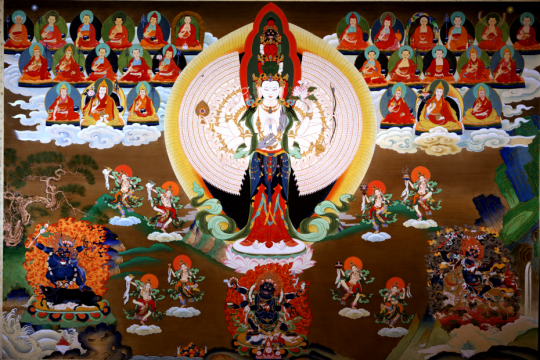
The nyung nä merit field. Original thangka painted by Peter Iseli
Saka Dawa is one of the four great holy days of the Tibetan calendar, commemorating Shakyamuni Buddha’s birth, enlightenment, and passing into parinirvana. During Saka Dawa, karmic results are multiplied by one hundred million, as cited by Lama Zopa Rinpoche in the vinaya text Treasure of Quotations and Logic. It is a very powerful time to practice.
The nyung nä retreat is a two-day intensive practice associated with Chenrezig that includes taking the eight Mahayana precepts for twenty-hour hours, with the addition of complete fasting and silence on the second day. The purifying power of nyung nä makes it an excellent practice to engage in over Saka Dawa.
In Abiding in the Retreat: A Nyung Nä Commentary, a new book by Lama Zopa Rinpoche forthcoming from the Lama Yeshe Wisdom Archive this year, Rinpoche explains:
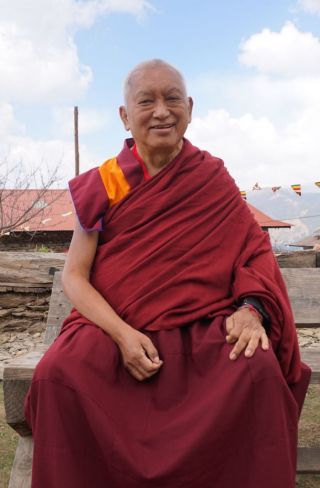
Lama Zopa Rinpoche in front of Thubten Shedrup Ling Monastery, Chailsa, Nepal, March 2017. Photo by Ven. Lobsang Sherab.
“Nyung nä is a practice that is very easy to do and yet has unbelievable power. There is extraordinary benefit in doing nyung näs. Everybody should definitely attempt to do nyung nä practice, this powerful method of purification. You shouldn’t regard nyung nä practice as unimportant and be careless about it. You must practice it, and from your heart you must recite OM MANI PADME HUM.
“Doing this practice is an unbelievably powerful way to collect the most extensive merit and to purify the negative karmas collected during beginningless rebirths. Doing that is a most powerful way to develop realizations, especially compassion for sentient beings. Doing Chenrezig meditation-recitation can really purify any negative karma and is the quickest way to achieve enlightenment. Don’t miss the opportunity to do this practice. And the harder you find it to do, the better it is, because you will purify more negative karma. As well as bringing powerful purification, however, it helps you to develop so much compassion for sentient beings. Nyung nä practice is also very effective in healing sicknesses, even those that are difficult to cure, where other methods have been tried and haven’t helped. By confessing to the guru, reciting the Chenrezig mantra and doing nyung näs, people have been cured of such sicknesses. Nyung nä is very powerful.”
This year, Saka Dawa is on June 9. FPMT Education Services would like to remind you about some nyung nä materials available to you:
Lama Zopa Rinpoche has also recommended other practices for special multiplying days such as Saka Dawa, including reciting the Sutra Remembering the Three Jewels.
Mandala magazine will publish “The Benefits of Nyung Nä Practice,” an excerpt from Lama Zopa Rinpoche’s new 2017 book Abiding in the Retreat: A Nyung Nä Commentary, in its upcoming issue, out June 21. Get the next issue of Mandala as a Friend of FPMT.
Through comprehensive study programs, practice materials, training seminars, and scholarships, FPMT Education nourishes the development of compassion, wisdom, kindness, and true happiness in individuals of all ages.
11
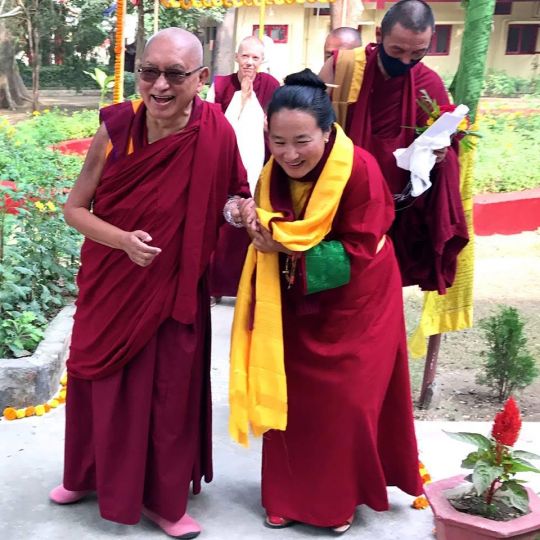
Lama Zopa Rinpoche with Khadro-la (Rangjung Neljorma Khadro Namsel Drönme) in Bodhgaya, India, January 2017. Photo by Bill Kane.
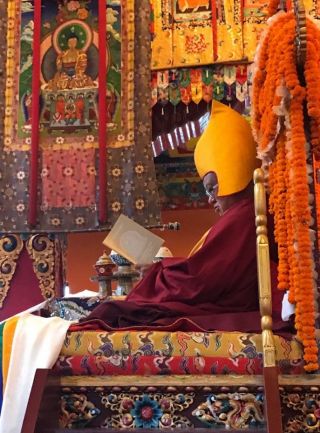
Lama Zopa Rinpoche during the long life puja offered to Rinpoche at Kopan Monastery, April 23, 2017. Photo by Ven. Roger Kunsang.
During a long life puja at Amitabha Buddhist Centre, Singapore, for Lama Zopa Rinpoche on March 13, 2016, Ven. Holly Ansett offered a beautiful long life prayer composed by Rangjung Neljorma Khadro Namsel Drönme (Khadro-la). We are pleased to make this prayer available in a variety of languages, including the newly revised English with Tibetan phonetics and Tibetan script.
As a reminder, Khadro-la recently advised that students of Lama Zopa Rinpoche are requested to offer recitations of the Vajra Cutter Sutra and the Dependent Arising: A Praise of the Buddha (Tendrel Topa) for Rinpoche’s long life. FPMT International Office has requested everyone to join in and keep track of their recitations of these prayers during the rest of this Tibetan year so that the total number of recitations can be offered to Rinpoche.
Through comprehensive study programs, practice materials, training seminars, and scholarships, FPMT Education nourishes the development of compassion, wisdom, kindness, and true happiness in individuals of all ages.
- Tagged: long life prayer, long life prayers
4
Golden Light Sutra for World Peace
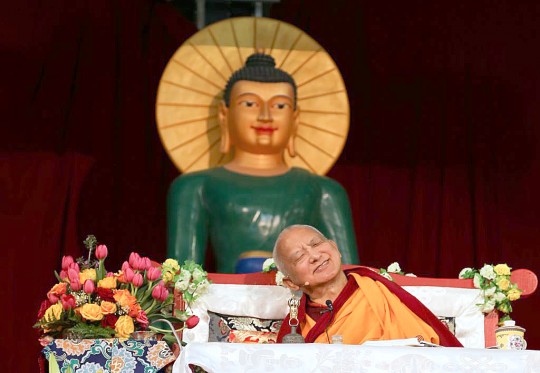
Lama Zopa Rinpoche teaching during the retreat in Australia, where he gave the oral transmission of Golden Light Sutra, Great Stupa of Universal Compassion, Australia, October 2014.
“Anybody who wants peace in the world should read the Golden Light Sutra,” Lama Zopa Rinpoche taught in 2007. “This is a very important practice to stop violence and wars in the world. The Golden Light Sutra is one of the most beneficial ways to bring peace. This is something that everyone can do, no matter how busy you are, even if you can read one page a day, or a few lines and in this way continually read the Golden Light Sutra.
“For anyone who desires peace for themselves and for others this is the spiritual, or Dharma, way to bring peace that doesn’t require you to harm others, doesn’t require you to criticize others or even to demonstrate against others, yet can accomplish peace. Anyone can read this text, Buddhists and even non-Buddhists who desire world peace.
“This also protects individuals and the country from what are labeled natural disasters of the wind element, fire element, earth element and water element, such as earthquakes, floods, cyclones, fires, tornadoes, etc. They are not natural because they come from causes and conditions that make dangers happen. They come from past inner negative thoughts and actions of people, and from external conditions. …”
During a retreat in Australia September-October 2014, Lama Zopa Rinpoche agreed to allow those who listen to a recording of Rinpoche giving the oral transmission to receive the transmission in full. You may receive this oral transmission by watching the video provided here or listening to the audio (see below).
Watch “Oral Transmission of Golden Light Sutra by Lama Zopa Rinpoche: All 21 Chapters” on YouTube: https://www.youtube.com/watch?v=3tFCRFtOKUg
If you would like to access the audio of this transmission only, you can download an MP3 for offline listening or enjoy the audio-only version on YouTube. You must listen to the entire sutra in order to receive the full transmission from Lama Zopa Rinpoche.
You can read Rinpoche’s complete advice on reciting the Golden Light Sutra for world peace on FPMT.org, where we have created a Golden Light Sutra resource page. On this page you can find links to more advice and many more resources, including the text in various languages.
- Tagged: golden light sutra, sutra of golden light
27
Mantras and Sutras Available
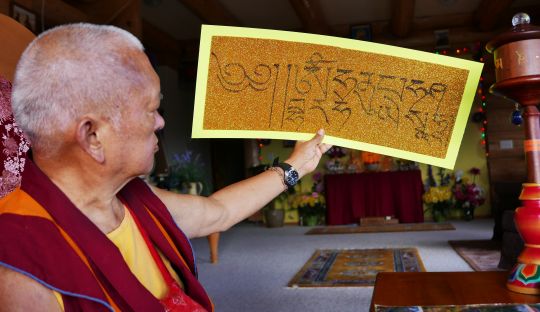
Lama Zopa Rinpoche examines a “Just By Seeing” Mantra he has written out. Washington, USA, October 2016
Both mantras and sutras are considered holy objects and bring great blessings to one’s mind and life through engagement. Dozens of commonly used and recommended mantras and sutras are available for students to download freely.
Lama Zopa Rinpoche has given extensive advice about mantra recitation and the benefits of particular sutras.
Please feel free to spend time on the FPMT Education sections of fpmt.org. Many resources for study and practice are available and we encourage all to take full advantage of these opportunities.
Through comprehensive study programs, practice materials, training seminars, and scholarships, FPMT Education nourishes the development of compassion, wisdom, kindness, and true happiness in individuals of all ages.
20
‘Abandon Stretching the Legs,’ A Living in the Path Module
In “Abandon Stretching the Legs,” a module of the Living in the Path program, Lama Zopa Rinpoche tells us to give up being lazy in our pursuit of understanding the nature of samsara and samsaric pleasures and to generate bodhichitta and strive to achieve enlightenment as quickly as possible.
In this short video Emily Hsu gives an introduction to the four-line verse: “Abandon stretching the legs. / Give up entering samsara. / Vajrasattva, the great king, / Urges again and again.” She explains that the first line reminds us to stop being lazy by remembering that death is definite and can happen any time; the second line reminds us to stop being fooled by samsaric pleasures; and the third and fourth lines exhort us to cherish others and strive to achieve enlightenment for their sake.
Watch “Abandon Stretching the Legs – An Exhortation to Give Up Laziness” on YouTube:
www.youtube.com/watch?v=4PBDPaIR2E0
A more detailed explanation of this verse can be found in the Living in the Path module “Abandon Stretching the Legs.”
All of the modules of the Living in the Path program are available on the FPMT Online Center. This program is ideal for anyone who wishes to deepen their personal practice and develop the realizations of the path to enlightenment by relying on Lama Zopa Rinpoche’s heart advice and teachings. As the teachings often assume familiarity with the lamrim, participants are recommended to have previously received teachings in the Tibetan Buddhist tradition.
Emily Hsu is a graduate of the first FPMT Masters Program 1998-2004 and in 2005 completed a ten-month solitary retreat in Spain. She began teaching at Gyalwa Gyatso in California in 2006 and became resident teacher there in 2012. Emily is an FPMT registered teacher.
Living in the Path is an FPMT Education program.
- Tagged: emily hsu, living in the path
- Home
- News/Media
- Study & Practice
- About FPMT Education Services
- Latest News
- Programs
- New to Buddhism?
- Buddhist Mind Science: Activating Your Potential
- Heart Advice for Death and Dying
- Discovering Buddhism
- Living in the Path
- Exploring Buddhism
- FPMT Basic Program
- FPMT Masters Program
- FPMT In-Depth Meditation Training
- Maitripa College
- Lotsawa Rinchen Zangpo Translator Program
- Universal Education for Compassion & Wisdom
- Online Learning Center
- Prayers & Practice Materials
- Overview of Prayers & Practices
- Full Catalogue of Prayers & Practice Materials
- Explore Popular Topics
- Benefiting Animals
- Chenrezig Resources
- Death & Dying Resources
- Lama Chopa (Guru Puja)
- Lama Zopa Rinpoche: Compendium of Precious Instructions
- Lama Zopa Rinpoche: Life Practice Advice
- Lama Zopa Rinpoche Practice Series
- Lamrim Resources
- Mantras
- Prayer Book Updates
- Purification Practices
- Sutras
- Thought Transformation (Lojong)
- Audio Materials
- Dharma Dates – Tibetan Calendar
- Translation Services
- Publishing Services
- Teachings and Advice
- Find Teachings and Advice
- Lama Zopa Rinpoche Advice Page
- Lama Zopa Rinpoche: Compendium of Precious Instructions
- Lama Zopa Rinpoche Video Teachings
- ༧སྐྱབས་རྗེ་བཟོད་པ་རིན་པོ་ཆེ་མཆོག་ནས་སྩལ་བའི་བཀའ་སློབ་བརྙན་འཕྲིན།
- Podcasts
- Lama Yeshe Wisdom Archive
- Buddhism FAQ
- Dharma for Young People
- Resources on Holy Objects
- Ways to Offer Support
- Centers
- Affiliates Area
- Teachers
- Projects
- Charitable Projects
- Make a Donation
- Applying for Grants
- News about Projects
- Other Projects within FPMT
- Support International Office
- Projects Photo Galleries
- Give Where Most Needed
- FPMT
- Shop
Translate*
*powered by Google TranslateTranslation of pages on fpmt.org is performed by Google Translate, a third party service which FPMT has no control over. The service provides automated computer translations that are only an approximation of the websites' original content. The translations should not be considered exact and only used as a rough guide.The essence of the guru is wisdom: the perfectly clear and radiant state of mind in which bliss and the realization of emptiness are inseparably unified.







